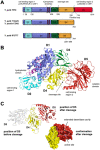The Cytotoxic Necrotizing Factors (CNFs)-A Family of Rho GTPase-Activating Bacterial Exotoxins
- PMID: 34941738
- PMCID: PMC8709095
- DOI: 10.3390/toxins13120901
The Cytotoxic Necrotizing Factors (CNFs)-A Family of Rho GTPase-Activating Bacterial Exotoxins
Abstract
The cytotoxic necrotizing factors (CNFs) are a family of Rho GTPase-activating single-chain exotoxins that are produced by several Gram-negative pathogenic bacteria. Due to the pleiotropic activities of the targeted Rho GTPases, the CNFs trigger multiple signaling pathways and host cell processes with diverse functional consequences. They influence cytokinesis, tissue integrity, cell barriers, and cell death, as well as the induction of inflammatory and immune cell responses. This has an enormous influence on host-pathogen interactions and the severity of the infection. The present review provides a comprehensive insight into our current knowledge of the modular structure, cell entry mechanisms, and the mode of action of this class of toxins, and describes their influence on the cell, tissue/organ, and systems levels. In addition to their toxic functions, possibilities for their use as drug delivery tool and for therapeutic applications against important illnesses, including nervous system diseases and cancer, have also been identified and are discussed.
Keywords: CNF; E. coli; Rho-GTPases; Yersinia; cytotoxic necrotizing factors; inflammation.
Conflict of interest statement
The authors declare no conflict of interest.
Figures



Similar articles
-
Cytotoxic Necrotizing Factors (CNFs)-A Growing Toxin Family.Toxins (Basel). 2010 Jan;2(1):116-27. doi: 10.3390/toxins2010116. Epub 2011 Apr 8. Toxins (Basel). 2010. PMID: 22069550 Free PMC article. Review.
-
A new turn in Rho GTPase activation by Escherichia coli cytotoxic necrotizing factors.Trends Microbiol. 2003 Apr;11(4):152-5. doi: 10.1016/s0966-842x(03)00042-8. Trends Microbiol. 2003. PMID: 12706988
-
Rho GTPase-activating bacterial toxins: from bacterial virulence regulation to eukaryotic cell biology.FEMS Microbiol Rev. 2007 Sep;31(5):515-34. doi: 10.1111/j.1574-6976.2007.00078.x. Epub 2007 Aug 3. FEMS Microbiol Rev. 2007. PMID: 17680807 Review.
-
Hierarchical determinants in cytotoxic necrotizing factor (CNF) toxins driving Rho G-protein deamidation versus transglutamination.mBio. 2024 Jul 17;15(7):e0122124. doi: 10.1128/mbio.01221-24. Epub 2024 Jun 26. mBio. 2024. PMID: 38920360 Free PMC article.
-
Escherichia coli cytotoxic necrotizing factors and Bordetella dermonecrotic toxin: the dermonecrosis-inducing toxins activating Rho small GTPases.Toxicon. 2001 Nov;39(11):1619-27. doi: 10.1016/s0041-0101(01)00149-0. Toxicon. 2001. PMID: 11595625 Review.
Cited by
-
Unravelling bacterial virulence factors in yeast: From identification to the elucidation of their mechanisms of action.Arch Microbiol. 2024 Jun 15;206(7):303. doi: 10.1007/s00203-024-04023-2. Arch Microbiol. 2024. PMID: 38878203 Review.
-
Meeting report 'Microbiology 2023: from single cell to microbiome and host', an international interacademy conference in Würzburg.Microlife. 2024 Apr 5;5:uqae008. doi: 10.1093/femsml/uqae008. eCollection 2024. Microlife. 2024. PMID: 38665235 Free PMC article.
-
C500 variants conveying complete mucosal immunity against fatal infections of pigs with Salmonella enterica serovar Choleraesuis C78-1 or F18+ Shiga toxin-producing Escherichia coli.Front Microbiol. 2023 Sep 14;14:1210358. doi: 10.3389/fmicb.2023.1210358. eCollection 2023. Front Microbiol. 2023. PMID: 37779705 Free PMC article.
-
Klebsiella pneumoniae-OMVs activate death-signaling pathways in Human Bronchial Epithelial Host Cells (BEAS-2B).Heliyon. 2024 Apr 13;10(8):e29017. doi: 10.1016/j.heliyon.2024.e29017. eCollection 2024 Apr 30. Heliyon. 2024. PMID: 38644830 Free PMC article.
-
Phylogroup Homeostasis of Escherichia coli in the Human Gut Reflects the Physiological State of the Host.Microorganisms. 2025 Jul 4;13(7):1584. doi: 10.3390/microorganisms13071584. Microorganisms. 2025. PMID: 40732093 Free PMC article.
References
-
- Von Pawel-Rammingen U., Telepnev M.V., Schmidt G., Aktories K., Wolf-Watz H., Rosqvist R. GAP Activity of the Yersinia YopE Cytotoxin Specifically Targets the Rho Pathway: A Mechanism for Disruption of Actin Microfilament Structure. Mol. Microbiol. 2000;36:737–748. doi: 10.1046/j.1365-2958.2000.01898.x. - DOI - PubMed
Publication types
MeSH terms
Substances
LinkOut - more resources
Full Text Sources
Other Literature Sources

